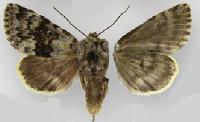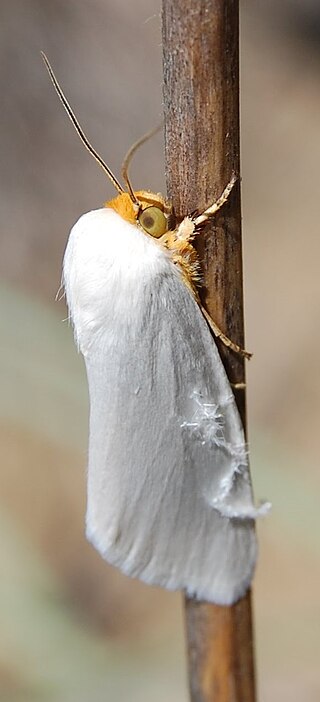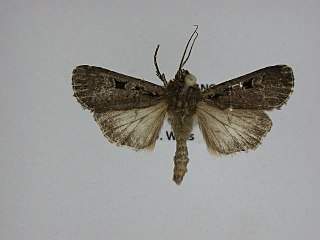
The Noctuidae, commonly known as owlet moths, cutworms or armyworms, are a family of moths. They are considered the most controversial family in the superfamily Noctuoidea because many of the clades are constantly changing, along with the other families of the Noctuoidea. It was considered the largest family in Lepidoptera for a long time, but after regrouping Lymantriinae, Catocalinae and Calpinae within the family Erebidae, the latter holds this title now. Currently, Noctuidae is the second largest family in Noctuoidea, with about 1,089 genera and 11,772 species. This classification is still contingent, as more changes continue to appear between Noctuidae and Erebidae.

Clytus arietis, the wasp beetle, is a wasp-mimicking longhorn beetle species in the genus Clytus.

Acronicta rumicis, the knot grass moth, is a species of moth which is part of the genus Acronicta and family Noctuidae. It was first described by Carl Linnaeus in his 1758 10th edition of Systema Naturae. It is found in the Palearctic region. A. rumicis lives and feeds on plants located in wide-open areas. At its larval stage, as a caterpillar, it causes such a large impact as a crop pest that it has received much attention and research. A. rumicis feeds on maize, strawberries and other herbaceous plants.

Euxoa nigrofusca, the white-line dart, is a moth of the family Noctuidae. It is found from Europe, to southern Siberia, central Asia to the Pacific Ocean. In North Africa it is known from Morocco and Algeria.

Agrotis innominata is a species of moth of the family Noctuidae. It is found in the coastal regions of New Zealand and is the only Agrotis species that is endemic to New Zealand.

Lasionycta is a genus of moths of the family Noctuidae.
Caradrina meralis, the rare sand Quaker, is a moth of the family Noctuidae. The species was first described by Herbert Knowles Morrison in 1875. It is found in North America from New Jersey and New Hampshire, Ontario, Ohio and Wisconsin west across southern Canada to British Columbia, south to California and Arizona.

The white flower moth is a moth of the family Noctuidae found in the United States and Canada. It is designated as Endangered under Canada's Species At Risk Act and Manitoba's Endangered Species and Ecosystems Act.

Copablepharon fuscum, the sand-verbena moth, is a moth of the family Noctuidae. It is found on sandy ocean beaches in British Columbia and Washington.

Euxoa tessellata, the tessellate dart or striped cutworm is a moth of the family Noctuidae. It is the most widespread Euxoa-species in North America. It is found from Newfoundland to Alaska, south in the west to California, Arizona, New Mexico, south in the east to Florida. It seems to be absent from Texas and adjacent eastern states.

Euxoa detersa, the rubbed dart, sandhill cutworm or sand cutworm, is a moth of the family Noctuidae. The species was first described by Francis Walker in 1856. It is found in North America from Newfoundland to North Carolina, west to Nebraska, north to Alberta and the Northwest Territories.

Psammopolia is a genus of moths of the family Noctuidae.

Psammopolia wyatti is a moth of the family Noctuidae first described by William Barnes and Foster Hendrickson Benjamin in 1926. It occurs in western North America from southern Oregon to the Queen Charlotte Islands of British Columbia. The moth has been included in both 1983 and 2010 MONA indices.

Psammopolia insolens is a moth of the family Noctuidae. It occurs on Pacific Coast sand beaches in central California from Carmel to Bodega Bay, Sonoma County. Most specimens are from near San Francisco.

Amyna axis, the oriental eight-spot, is a moth of the family Noctuidae. The species was first described by Achille Guenée in 1852.

Euxoa muldersi is a moth of the family Noctuidae. It is known only from north central Canada with all specimens except two from the vicinity of Arviat, Nunavut. It is restricted to open dunes where it flies close to the sand.

The Erebinae are a subfamily of moths in the family Erebidae erected by William Elford Leach in 1815. Erebine moths are found on all continents except Antarctica, but reach their greatest diversity in the tropics. While the exact number of species belonging to the Erebinae is not known, the subfamily is estimated to include around 10,000 species. Some well-known Erebinae include underwing moths (Catocala) and witch moths (Thermesiini). Many of the species in the subfamily have medium to large wingspans, up to nearly 30 cm in the white witch moth, which has the widest wingspan of all Lepidoptera. Erebine caterpillars feed on a broad range of plants; many species feed on grasses and legumes, and a few are pests of castor bean, sugarcane, rice, as well as pistachios and blackberries.
The Micronoctuini are a tribe of moths in the family Erebidae that includes about 400 described species. Typical species in the tribe have bifine hindwing venation and are smaller than those in other noctuoid moths. Micronoctua karsholti is the smallest of all species in the superfamily Noctuoidea.

Aleptina arenaria is a moth of the family Noctuidae. It is only known from the White Sands National Park, Otero County, New Mexico.

Ichneutica oliveri is a moth of the family Noctuidae. It is endemic to New Zealand, found only in the South Island. However it has not been observed on the eastern side of that island from mid-Canterbury southwards to Southland. This species is distinctive and is unlikely to be confused with other closely related species. It inhabits tussock grasslands, shrubland as well as granite sand plains, all in the alpine zone. Adults are on the wing from December to March and are attracted to light. They have been observed feeding on the flowers of Hebe species. The life history of this species is unknown as are the larval hosts.














